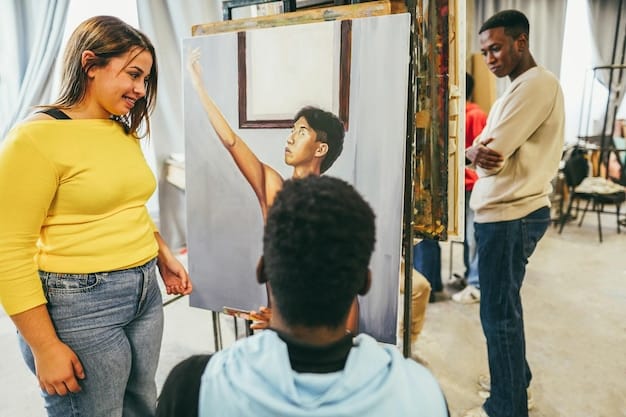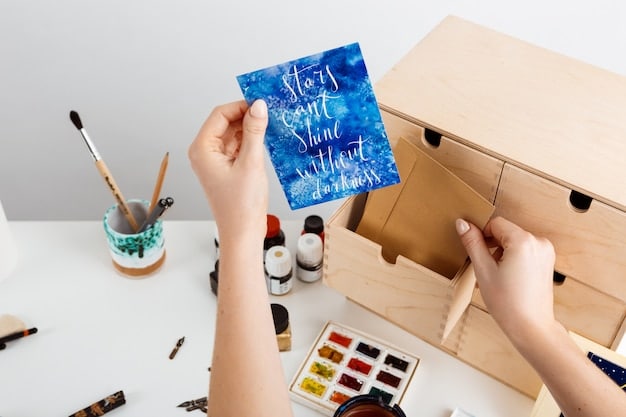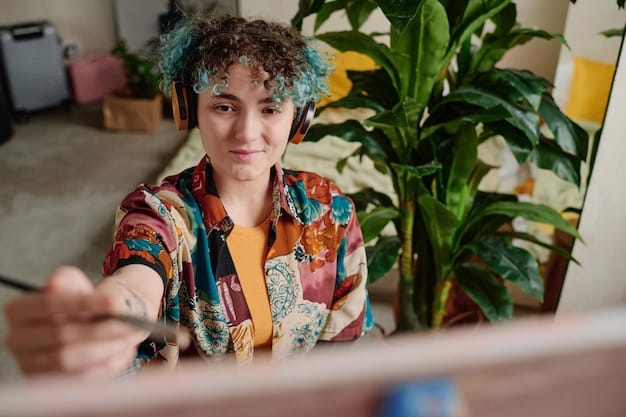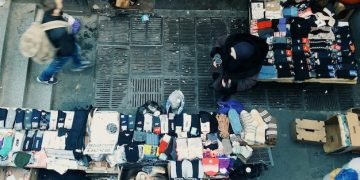Networking for Emerging Artists: Connect & Succeed

Emerging Artists can significantly boost their careers by implementing strategic networking, connecting with industry professionals, and leveraging opportunities for exposure and collaboration within the competitive art world.
Are you an emerging artist looking to make your mark in the art world? Strategic networking isn’t just about attending events; it’s a vital skill that can open doors to collaborations, exhibitions, and career-defining opportunities. Let’s explore how to connect with industry professionals and set yourself up for success.
Building Your Foundation: Online Presence and Branding
Before stepping into the bustling art scene, establishing a solid foundation is crucial. This involves crafting a compelling online presence and refining your personal brand to attract the right attention. Your digital footprint is often the first impression you make on industry professionals.
Crafting a Professional Website
Your website serves as your digital portfolio, showcasing your best works and providing a glimpse into your artistic vision. It’s more than just a gallery; it’s your online identity.
Mastering Social Media
Social media platforms offer unparalleled opportunities to connect with fellow artists, galleries, and potential collectors. However, it’s essential to use these tools strategically.
- Consistency is Key: Regularly post high-quality images of your artwork and engage with your followers.
- Platform Optimization: Tailor your content to suit each platform; Instagram for visual appeal, LinkedIn for professional connections.
- Hashtag Strategy: Use relevant hashtags to increase visibility and reach a wider audience.
In conclusion, a strong online presence is pivotal for emerging artists aiming to network effectively. It lays the groundwork for making meaningful connections and showcasing your work professionally.

Navigating Art Events and Workshops
Art events and workshops provide invaluable opportunities to meet influential figures in the art world. By attending these gatherings, you not only immerse yourself in the community but also open doors to potential mentors and collaborators. Knowing how to navigate these events effectively is key.
Choosing the Right Events
Not all art events are created equal. Focus on those that align with your artistic style and career goals. Research events ahead of time and prioritize those with relevant attendees.
Making Meaningful Connections
Networking isn’t just about collecting business cards; it’s about building genuine relationships. Approach conversations with curiosity and authenticity.
- Prepare an Elevator Pitch: Craft a concise and engaging summary of your artistic brand.
- Listen Actively: Show genuine interest in others’ work and perspectives.
- Follow Up: Send personalized thank-you notes or emails to those you connected with.
Attending art events is a significant step towards expanding your network and making meaningful connections. By strategically choosing events and engaging thoughtfully, emerging artists can create lasting relationships within their community.
Leveraging Online Platforms and Communities
Beyond traditional art events, online platforms and communities provide a virtual space for artists to connect, collaborate, and gain exposure. These platforms offer a diverse range of opportunities for emerging artists to build their network and interact with a global audience.
Joining Online Art Communities
Online art communities provide a nurturing environment for artists to share their work, receive feedback, and discover collaborations. These communities can amplify your reach and connect you with artists from around the world.
Participating in Online Discussions
Engaging in online discussions allows you to share your expertise, learn from others, and establish yourself as a knowledgeable member of the art community.
- Share Your Insights: Provide constructive feedback on other artists’ work.
- Ask Thoughtful Questions: Engage in discussions to deepen your understanding of industry trends.
- Stay Active: Regularly participate in discussions to maintain visibility and stay connected.
Online platforms and communities can be powerful tools for networking online. They provide a virtual space for peer support, exposure, and collaboration, enhancing your overall presence in the art world.

Collaborating with Fellow Artists
Collaborating with fellow artists can bring fresh perspectives, expand your skill set, and introduce your work to new audiences. These partnerships can be mutually beneficial, offering opportunities for growth and innovation.
Finding the Right Collaborators
Seek out artists whose work complements your own. Look for collaborations that will challenge you creatively and help you develop new skills.
Creating Joint Projects
Collaborative projects can range from совместные exhibitions to совместные installations. The key is to create a project that blends the unique talents of both artists.
- Define Clear Roles: Establish each artist’s responsibilities to avoid confusion and ensure smooth progress.
- Set Shared Goals: Align your artistic visions to create a cohesive and compelling project.
- Promote Jointly: Use both artists’ networks to maximize exposure for the collaboration.
Collaborating with fellow artists can lead to stimulating experiences and expand your reach. By combining talents, you create opportunities to grow artistically and gain momentum in your career.
Building Relationships with Galleries and Curators
Establishing relationships with galleries and curators is a pivotal step for any emerging artist. These interactions can lead to exhibition opportunities, representation, and increased visibility. Approach these connections with professionalism and respect.
Researching Potential Galleries
Before reaching out to galleries, research their artistic focus and past exhibitions. Make sure that your work aligns with their mission and style.
Preparing Your Portfolio
Your portfolio is your calling card. It should showcase your best work and reflect your artistic vision. Include a variety of mediums and styles to demonstrate your versatility.
- Curate Your Best Pieces: Select works that best represent your artistic identity.
- Write Compelling Descriptions: Provide context and insight into your artwork.
- Present Professionally: Ensure that your portfolio is visually appealing and easy to navigate.
Cultivating relationships with galleries can significantly impact your artistic career. Prepare thoroughly and approach galleries with professionalism and respect to establish lasting partnerships.
Mastering the Art of Self-Promotion
Self-promotion is an essential skill for emerging artists. Effectively communicating your artistic vision and achievements can attract attention from galleries, collectors, and the media. Embrace self-promotion as an important part of your career.
Writing Compelling Artist Statements
Your artist statement is your opportunity to articulate your artistic vision and connect with your audience. Craft a statement that is both informative and engaging.
Press Release
A press release enables you to communicate your message to the masses on all things that involve you and your career. Keep it short and to the point.
- Highlight Key Themes: Explain the central ideas and inspirations behind your body of work.
- Share Your Journey: Provide context about your artistic background and influences.
- Use Engaging Language: Capture the reader’s attention with vivid and expressive prose.
Mastering the art of self-promotion is crucial for emerging artists. By speaking confidently about your craft and achievements, you can attract the attention and recognition you deserve.
| Key Point | Brief Description |
|---|---|
| 💼 Online Presence | Craft a professional website and optimize your social media presence. |
| 🎨 Art Events | Attend relevant events and make genuine connections with professionals. |
| 🤝 Collaborations | Partner with fellow artists to amplify exposure and exchange skills. |
| 📢 Self-Promotion | Master the art of communicating your artistic vision effectively. |
FAQ
▼
Research their gallery thoroughly, attend their openings to show genuine interest, and then send a personalized email with a concise portfolio showcasing your best work.
▼
Invest in a professional website and optimize your social media profiles. Use high-quality images of your work, maintain consistency, and engage actively with your audience.
▼
Focus on events that align with your artistic style and career goals. Gallery openings, art fairs, artist talks, and workshops are all excellent choices for meeting industry professionals.
▼
Collaborating with other artists can expand your skill set, introduce your work to new audiences, and lead to fresh perspectives. It’s a great way to grow both artistically and professionally.
▼
Craft a compelling artist statement, leverage social media, attend relevant events, and maintain an active presence in online art communities. Consistency and genuine engagement are key.
Conclusion
In conclusion, strategic networking is essential for emerging artists looking to succeed. By combining a strong online presence, active participation in art events, collaborations, and effective self-promotion, you can connect with industry professionals and unlock valuable opportunities.





